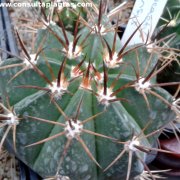Care of the cactus Melocactus bahiensis or Cactus bahiensis |
|
The genus Melocactus, family Cactaceae, comprises 40 species of cacti native to Mexico, Cuba, Central and South America. Some species are: Melocactus bahiensis, Melocactus azureus, Melocactus curvispinus, Melocactus oreas, Melocactus conoideus, Melocactus intortus, Melocactus intortus, Melocactus deinacanthus, Melocactus schatzlii, Melocactus peruvianus, Melocactus ernestii, Melocactus matanzanus. Scientific synonyms: Cactus bahiensis. This species is native to Eastern Brazil. They are very slow-growing cacti with a globular gray-green body that can reach 20 cm (7.87") in height. They have 10-12 fairly prominent ribs. 7-10 gray radial spines and 1-4 central spines of the same color appear on the whitish areolas. Pink flowers and red fruits app, ear on the woolly cephalium. Cactus bahiensis is used in pots on terraces, balconies, in well-ventilated interiors, in greenhouses, on rockeries, and in cactus and succulent gardens. Melocactus bahiensis can grow in full sun or semi-shade exposure. It's important that in winter the temperature is not lower than 13 ºC (55.4 ºF). The soil can be a mixture of 3/4 of leaf mulch or heather soil and 1/4 of coarse gravel. Always water moderately at the rate of once every 15 days in spring, every 7-8 days in summer, every 20-25 days in autumn and do not water in winter. Fertilize in spring with mineral fertilizer for cacti. Melocactus bahiensis does not need pruning. If there is no excess of humidity, it does not usually present problems of pests and diseases. Cactus bahiensis propagates from seeds sown in spring; it's a simple but slow process. |
Images of the cactus Melocactus bahiensis or Cactus bahiensis |
Find plants
Melocactus bahiensis or Cactus bahiensis | Care and Growing
© 2026 FavThemes

